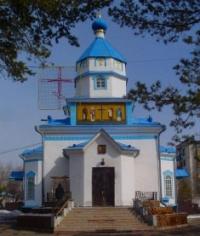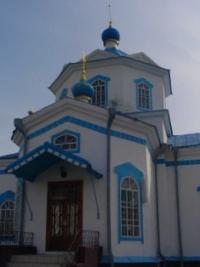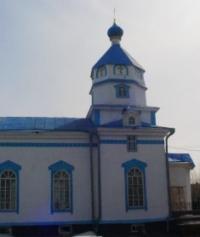Вы здесь
Konstantin-Eleninsky church.



Historic sights in cities of Kazakhstan.
"If God Does Not Hear Me Above
I will turn my prayers to Satan.
If the wishes of God are not pleasing to me
So the devil inspires me with desires!”
Omar Khayyam.
Excursion tours from Almaty to Astana.
The oldest Orthodox church in the city is located in the central part of the city near the Republic Avenue. Its construction is associated with the development of trade and an increase in the number of residents in Akmolinsk.
On September 12, 1849, the priest of the marching Akmola church, Mikhail Nikolsky, asked the border chief to allow the construction of the church to begin in early spring of 1850. The project and estimate for the construction of a wooden church were developed by June 1850.
The construction was entrusted to engineer-lieutenant G.A. Vorotnikov, a garrison fortification engineer. Vorotnikov carried out technical supervision of the construction of fortifications, military and civil buildings. Having acquainted with the project and the estimate, an experienced engineer, based on the geological conditions of the selected site, suggested reducing the depth of the foundation and the capacity of the foundation.
This allowed us to reduce excavation costs, construction materials, which, with a lack of funds, was very helpful. Omsk Engineering Department approved the changes to the project. The church was built in 1854 - 1856. at the expense of the treasury of the Siberian Cossack army.
At the time of the construction of the church in the Akmola fortification, a special construction committee was created, which included the commander of the military detachment, the garrison engineer G. A. Vorotnikov, the priest of the camp church, and representatives from parishioners.
The chairman of the committee approved the commander of the detachment Major Sizykh. His subordinates, in addition to performing their direct military duties, had to constantly work on construction. In 1853, the construction of a detachable headquarters building, overhaul of the dilapidated barracks, logging for pickets along the Karkaraly tract was to be strengthened.
Additional, and almost unpaid, work on the construction of the church could undermine both the health and material condition of the military. Understanding the situation, Major Sizykh requested that the church be built not by the forces of the detachment, but by free employment.
In March 1854, Major Sizykh was delivered from Omsk an urgent package. The letter stated: "...The Emperor deigned to deign in the Akmola fortification to build a church in the name of the Holy Equal-to-the-Apostles Tsars Constantine and Helen."
On July 8, 1856, the cathedral archpriest John Toropov consecrated the church in the name of the Holy Equal-to-the-Apostles Tsars Konstantin and Elena. The first rector of the church was the priest Michael Nikolsky. The final work on the external decoration of the temple was completed in the summer of 1858.
By a decree of April 27, 1893, the Tobolsk Spiritual Consistory allowed, at the request of the Akmola Cossacks, the transfer of the Konstantin-Eleninsky Church to the Akmolinskaya stanitsa on the square. The laying on stanitsa square was made on May 14, 1900. The transfer process was completed by early 1902.
As before, the temple was arranged by a single-throne in plan, sustained in the form of a regular cross, but significant changes also appeared: the temple became five-domed. This corresponded to the official direction of architecture of those years.
In 1938, the Church of Constantine-Elenin was closed. Crosses and bells were removed, the bells were disassembled. In 1940, the building was transferred to the Museum of History and Local Lore. During the Great Patriotic War in 1941 - 1942, a separate communications battalion of the 29th rifle division formed in Akmolinsk was located in the church building.
In 1942, at the numerous requests of believers, the resumption of worship in the Konstantin-Eleninsky church was allowed in Akmolinsk. The temple is single-throne in plan, five-domed, designed in the shape of a regular cross.
The length of the building is 33 m, the width is 8 m. Two prominent annexes on each side, giving the church a cross-plan view, are 3.6 x 4 m in size. Strict and at the same time, the elegant lines of the contours of the Orthodox church are directed upward, giving the building airy lightness and elegance.
Above the cubic volume rises an 8-sided drum with windows, covered with a gentle tent, completed with a glaucus. Above the narthex rises a bell tower with a rectangular base, an 8-sided drum and, in the upper part, spans of the belfry, also covered by a gentle tent with the same head as the central tent.
The bell tower is located above the western entrance to the building. Currently, it is plastered and gives the impression of stone. The monument is valuable as the only religious building in the city that has survived from the XIXth century and reflects the development of the city’s culture at a certain stage in the history of urban development.
The Roman emperor Constantine the Great (306 - 337) Is known in history for the publication in 313 of the Edict of Milan on religious tolerance and its spread in 323, after his intronation, to the entire empire. For the first time after three hundred years of persecution, Christians were given the opportunity to openly practice their faith.
Empress Helen, mother of Emperor Constantine, in 326, together with the Patriarch of Jerusalem, Macarius, found one of the main religions of the relics of the Christian world, the Life-Giving Cross, on which Jesus Christ was crucified.
While in Palestine, the empress ordered the liberation of all places connected with the earthly life of Christ from all traces of paganism, and commanded the Christian church to be erected in these memorable places.
Authority:
http://direkt-15.kz/arxitektura/konstantino-eleninskaya-czerkov-prospekt-respubliki,-12-b.html
Photos by
Alexander Petrov.







